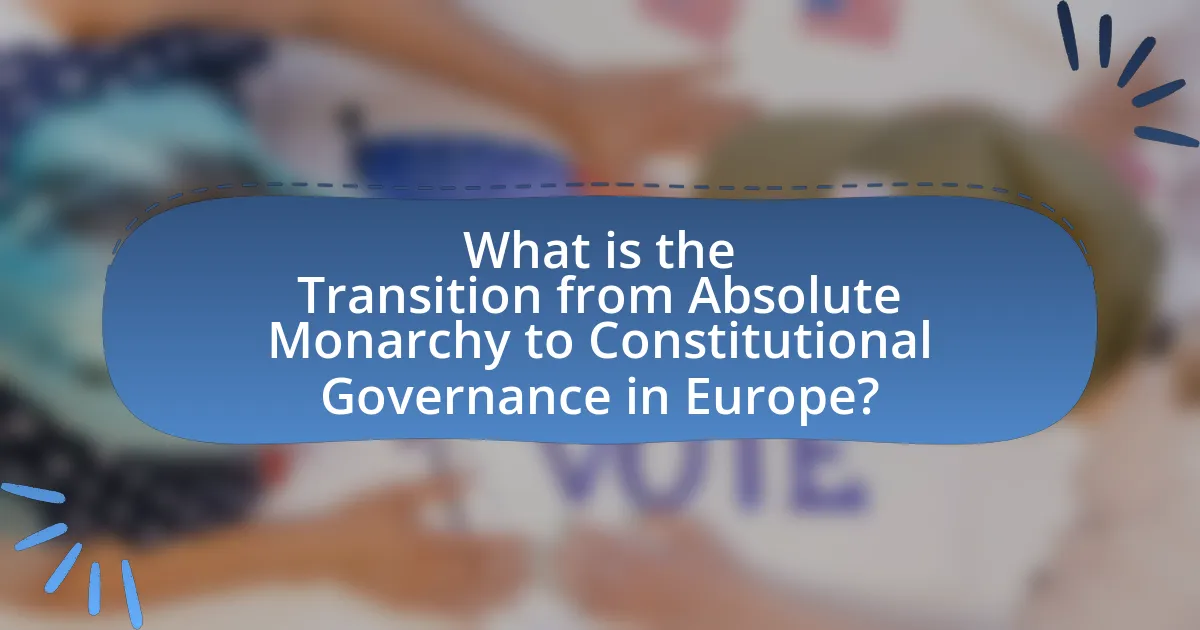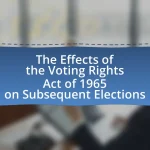The article examines the transition from absolute monarchy to constitutional governance in Europe, highlighting the shift from centralized, autocratic rule to systems where monarchs’ powers are limited by law and representative institutions. Key historical events such as the English Civil War, the Glorious Revolution, and the French Revolution are discussed, illustrating how Enlightenment ideas and social changes contributed to this transformation. The article also explores the characteristics of absolute monarchy, the prominent monarchs of the era, and the implications of this transition for individual rights, political structures, and modern governance. Additionally, it addresses the lasting effects on contemporary political ideologies and the challenges faced by modern democracies.

What is the Transition from Absolute Monarchy to Constitutional Governance in Europe?
The transition from absolute monarchy to constitutional governance in Europe involved a shift from centralized, autocratic rule to systems where monarchs’ powers were limited by law and representative institutions. This transformation was significantly influenced by events such as the English Civil War, the Glorious Revolution, and the Enlightenment, which promoted ideas of individual rights and government accountability. For instance, the English Bill of Rights in 1689 established parliamentary sovereignty and curtailed the powers of the monarchy, serving as a model for other nations. Additionally, the French Revolution in the late 18th century further exemplified this shift, leading to the establishment of constitutional frameworks that emphasized popular sovereignty and civil liberties. These historical milestones collectively illustrate the gradual evolution towards constitutional governance across Europe, marking a significant departure from the absolute rule that characterized earlier periods.
How did absolute monarchy function in Europe before the transition?
Absolute monarchy in Europe functioned as a system where the monarch held supreme authority, often justified by divine right. Monarchs, such as Louis XIV of France, centralized power, diminishing the influence of nobility and establishing a bureaucratic state to enforce their will. This concentration of power allowed monarchs to make laws, levy taxes, and govern without the need for consent from subjects or legislative bodies. Historical evidence shows that during the 17th and 18th centuries, absolute monarchs expanded their territories and strengthened their armies, further solidifying their control. The lack of checks and balances led to widespread discontent, ultimately paving the way for the transition to constitutional governance.
What were the key characteristics of absolute monarchy?
Absolute monarchy is characterized by the concentration of power in a single ruler, who wields unrestricted authority over the state and its governance. This form of government typically includes the absence of checks and balances, where the monarch’s decisions are not subject to legal limitations or legislative approval. Historical examples, such as Louis XIV of France, illustrate this concentration of power, as he famously stated, “L’état, c’est moi” (I am the state), reflecting the belief that the monarch embodies the state itself. Additionally, absolute monarchies often rely on divine right theory, which posits that monarchs derive their authority directly from God, further legitimizing their absolute rule.
Who were the prominent absolute monarchs in Europe?
Prominent absolute monarchs in Europe included Louis XIV of France, Peter the Great of Russia, and Frederick the Great of Prussia. Louis XIV, known as the “Sun King,” ruled from 1643 to 1715 and centralized power in France, famously stating, “L’état, c’est moi” (I am the state). Peter the Great, who reigned from 1682 to 1725, modernized Russia and expanded its territory, establishing it as a major European power. Frederick the Great ruled Prussia from 1740 to 1786, implementing significant military and administrative reforms that strengthened his state. These monarchs exemplified the principles of absolute monarchy, where the ruler held supreme authority, often justified by divine right.
What were the main factors leading to the transition?
The main factors leading to the transition from absolute monarchy to constitutional governance in Europe included the rise of Enlightenment ideas, economic changes, and social upheaval. Enlightenment thinkers like John Locke and Montesquieu advocated for individual rights and the separation of powers, influencing public opinion and political thought. Economic changes, particularly the growth of trade and the middle class, diminished the absolute power of monarchs by increasing demands for political representation. Social upheaval, exemplified by events such as the French Revolution, challenged the legitimacy of monarchies and pushed for democratic reforms. These factors collectively contributed to the shift towards constitutional governance across Europe.
How did Enlightenment ideas influence the transition?
Enlightenment ideas significantly influenced the transition from absolute monarchy to constitutional governance in Europe by promoting principles of individual rights, reason, and the social contract. Philosophers like John Locke argued that government should be based on the consent of the governed, which challenged the divine right of kings and legitimized the demand for constitutional frameworks. The Enlightenment emphasized rational thought and empirical evidence, leading to the questioning of traditional authority and the advocacy for democratic governance. This ideological shift was evident in events such as the American Revolution (1776) and the French Revolution (1789), where Enlightenment principles were directly applied to establish governments that reflected the will of the people rather than the whims of monarchs.
What role did social and economic changes play in the transition?
Social and economic changes were pivotal in the transition from absolute monarchy to constitutional governance in Europe. The rise of the middle class, fueled by industrialization and urbanization, created a demand for political representation and individual rights, challenging the traditional power structures of monarchies. Economic shifts, such as the expansion of trade and the emergence of capitalist economies, undermined the feudal system and promoted ideas of liberty and equality, as seen during the Enlightenment. These changes fostered revolutionary movements, exemplified by the French Revolution, which directly led to the establishment of constitutional frameworks that limited monarchical power and promoted democratic governance.
What were the significant events marking the transition?
The significant events marking the transition from absolute monarchy to constitutional governance in Europe include the English Civil War (1642-1651), the Glorious Revolution (1688), and the French Revolution (1789). The English Civil War resulted in the temporary overthrow of King Charles I and established the precedent for parliamentary sovereignty. The Glorious Revolution led to the establishment of constitutional monarchy in England, with William and Mary accepting the Bill of Rights in 1689, which limited royal power and affirmed parliamentary authority. The French Revolution challenged absolute monarchy in France, culminating in the Declaration of the Rights of Man and of the Citizen in 1789, which laid the groundwork for modern democratic principles and constitutional governance. These events collectively shifted power from monarchs to representative institutions, fundamentally altering the political landscape of Europe.
How did the English Civil War contribute to constitutional governance?
The English Civil War significantly contributed to constitutional governance by challenging the absolute authority of the monarchy and establishing the principle that sovereignty resides with Parliament. The conflict, which lasted from 1642 to 1651, led to the execution of King Charles I in 1649 and the temporary establishment of the Commonwealth under Oliver Cromwell. This shift marked a pivotal moment in English history, as it laid the groundwork for the eventual development of constitutional monarchy, where the powers of the monarchy were limited by law and parliamentary consent. The subsequent Restoration in 1660 and the Glorious Revolution of 1688 further solidified these principles, culminating in the Bill of Rights 1689, which enshrined parliamentary supremacy and individual rights, thereby institutionalizing constitutional governance in England.
What impact did the French Revolution have on the transition?
The French Revolution significantly accelerated the transition from absolute monarchy to constitutional governance in Europe. It dismantled the feudal system and challenged the divine right of kings, leading to the establishment of republican ideals and the concept of popular sovereignty. The revolution inspired a wave of uprisings and reforms across Europe, as seen in countries like Belgium, Italy, and Germany, where revolutionary movements sought to limit monarchical power and promote democratic governance. The Declaration of the Rights of Man and of the Citizen, adopted in 1789, served as a foundational document that influenced constitutional frameworks in various nations, emphasizing individual rights and the rule of law.

How did the transition impact European societies?
The transition from absolute monarchy to constitutional governance significantly impacted European societies by promoting democratic principles and individual rights. This shift led to the establishment of legal frameworks that limited the powers of monarchs and emphasized the rule of law, as seen in documents like the Magna Carta and the French Declaration of the Rights of Man and of the Citizen. These changes fostered political participation among citizens, encouraged the rise of political parties, and facilitated the development of civil society organizations, ultimately transforming the relationship between the state and its citizens. The impact is evidenced by the widespread revolutions and reforms across Europe in the 18th and 19th centuries, which dismantled feudal structures and paved the way for modern democratic states.
What changes occurred in political structures after the transition?
After the transition from absolute monarchy to constitutional governance in Europe, political structures shifted towards representative democracy and the establishment of constitutional frameworks. This change resulted in the reduction of monarchical power, as seen in countries like France and England, where monarchs became subject to the law and parliamentary authority. The adoption of constitutions, such as the French Constitution of 1791, formalized the separation of powers and established civil rights, thereby promoting individual liberties and limiting governmental authority. These developments were further evidenced by the rise of parliamentary systems, where elected representatives gained significant influence over legislation and governance, marking a departure from autocratic rule.
How did the role of the monarchy evolve in constitutional governance?
The role of the monarchy evolved from absolute power to a constitutional framework where monarchs serve primarily as ceremonial figures within a system of governance defined by laws and elected representatives. This transformation began in the 17th century, particularly with events like the English Civil War and the Glorious Revolution, which established parliamentary sovereignty and limited royal authority. The Bill of Rights 1689 in England exemplified this shift, affirming that the monarchy could not govern without Parliament’s consent, thereby institutionalizing the principle of constitutional monarchy. As a result, monarchs became symbolic leaders, with real political power residing in elected bodies, reflecting a broader trend across Europe where constitutional governance emerged to balance authority and protect individual rights.
What new political institutions emerged during this period?
During the transition from absolute monarchy to constitutional governance in Europe, new political institutions such as constitutional monarchies, parliaments, and representative assemblies emerged. Constitutional monarchies, exemplified by the United Kingdom after the Glorious Revolution of 1688, established a system where the monarch’s powers were limited by law and balanced by elected representatives. Parliaments, like the English Parliament, gained legislative authority, allowing for the representation of the populace and the ability to create laws. Additionally, representative assemblies, seen in various European states, provided a platform for citizens to participate in governance, reflecting the shift towards democratic principles and accountability in government.
How did the transition affect individual rights and freedoms?
The transition from absolute monarchy to constitutional governance significantly expanded individual rights and freedoms. This shift introduced legal frameworks that protected citizens’ rights, such as the right to free speech, assembly, and due process, which were often suppressed under absolute rule. For instance, the English Bill of Rights of 1689 established limits on the powers of the monarchy and affirmed the rights of Parliament and individuals, marking a pivotal moment in the recognition of civil liberties. Additionally, the French Revolution’s Declaration of the Rights of Man and of the Citizen in 1789 further codified individual rights, emphasizing equality and liberty, which were foundational to modern democratic principles. These historical documents and events illustrate how the transition facilitated a broader acknowledgment and protection of individual rights and freedoms in Europe.
What were the implications for civil liberties in constitutional states?
The implications for civil liberties in constitutional states included the establishment of legal protections for individual rights and the limitation of government power. Constitutional governance marked a shift from absolute monarchy, where rulers held unchecked authority, to systems that enshrined civil liberties such as freedom of speech, assembly, and religion. For example, the English Bill of Rights of 1689 codified specific rights and set limits on the powers of the monarchy, ensuring that citizens had legal recourse against government overreach. This transition facilitated the development of democratic principles and the rule of law, which further reinforced civil liberties across Europe.
How did the transition influence the concept of citizenship?
The transition from absolute monarchy to constitutional governance significantly redefined the concept of citizenship by shifting the focus from subjects of the monarch to active participants in a political community. This change emphasized individual rights and civic responsibilities, as seen in documents like the Magna Carta and the Declaration of the Rights of Man and of the Citizen, which established that citizenship entails not only privileges but also duties to the state. The Enlightenment ideals promoted by philosophers such as John Locke and Jean-Jacques Rousseau further reinforced this notion, advocating for the idea that citizens have a role in governance through representation and the social contract. Consequently, citizenship evolved to encompass legal status, political participation, and the protection of individual rights, marking a fundamental transformation in the relationship between the state and its citizens.
What were the social consequences of the transition?
The social consequences of the transition from absolute monarchy to constitutional governance in Europe included the rise of individual rights and the decline of feudal privileges. This shift empowered the middle class and common citizens, leading to increased political participation and the establishment of civil liberties. For instance, the French Revolution (1789) exemplified this change, as it abolished the feudal system and promoted the Declaration of the Rights of Man and of the Citizen, which asserted equality and freedom. Additionally, the transition fostered a sense of national identity and civic responsibility, as citizens began to view themselves as part of a collective governed by laws rather than by the whims of a monarch.
How did class structures change in post-monarchical societies?
Class structures in post-monarchical societies shifted from rigid hierarchies dominated by nobility to more fluid systems emphasizing merit and citizenship. This transformation occurred as absolute monarchies were replaced by constitutional governance, which promoted individual rights and social mobility. For instance, the French Revolution (1789) dismantled feudal privileges, leading to the rise of the bourgeoisie as a powerful social class, while the establishment of parliamentary systems in various European nations further encouraged the participation of the middle class in politics and economy. These changes were marked by the decline of aristocratic power and the emergence of democratic ideals, which facilitated the redistribution of wealth and influence across broader segments of society.
What role did women play in the transition to constitutional governance?
Women played a significant role in the transition to constitutional governance by advocating for political rights and social reforms. During the Enlightenment, women like Mary Wollstonecraft argued for equality and the right to participate in governance, influencing public opinion and political thought. Their involvement in salons and political movements helped to challenge traditional power structures and promote ideas of democracy and citizenship. For instance, the French Revolution saw women actively participating in protests and political clubs, demanding rights and representation, which highlighted their crucial role in shaping the discourse around constitutional governance.

What are the lasting effects of the transition on modern governance in Europe?
The lasting effects of the transition from absolute monarchy to constitutional governance in Europe include the establishment of democratic institutions, the rule of law, and the protection of individual rights. This transition fundamentally altered the power dynamics within European states, leading to the creation of parliamentary systems that limit the authority of monarchs and promote representative governance. Historical events such as the English Civil War and the Glorious Revolution exemplify this shift, resulting in constitutional frameworks that prioritize civil liberties and accountability. The adoption of documents like the Magna Carta and the Bill of Rights further solidified these principles, influencing modern governance structures across Europe. Consequently, contemporary European democracies are characterized by checks and balances, separation of powers, and a commitment to human rights, all rooted in the legacy of this significant transition.
How did the transition shape contemporary political ideologies?
The transition from absolute monarchy to constitutional governance in Europe fundamentally shaped contemporary political ideologies by promoting the principles of democracy, individual rights, and the rule of law. This shift led to the emergence of liberalism, which emphasizes personal freedoms and limited government, as well as republicanism, advocating for representative government and civic participation. Historical events such as the Glorious Revolution in England (1688) and the French Revolution (1789) exemplified this transition, as they challenged the divine right of kings and established frameworks for constitutional governance. These revolutions inspired subsequent movements across Europe and the world, embedding the ideas of popular sovereignty and civil liberties into modern political thought.
What influence did the transition have on liberalism and democracy?
The transition from absolute monarchy to constitutional governance significantly advanced liberalism and democracy by promoting individual rights and limiting governmental power. This shift established frameworks for representative government, as seen in the English Bill of Rights of 1689, which curtailed the monarch’s authority and laid the groundwork for parliamentary democracy. Additionally, the Enlightenment ideals that emerged during this period emphasized reason, equality, and the social contract, further embedding democratic principles in European societies. The influence of these changes is evident in the subsequent revolutions, such as the American Revolution (1776) and the French Revolution (1789), which sought to implement liberal democratic ideals and challenge autocratic rule.
How did the transition affect the development of political parties?
The transition from absolute monarchy to constitutional governance significantly influenced the development of political parties by fostering a political environment that encouraged representation and pluralism. This shift allowed for the emergence of organized groups that sought to represent diverse interests and ideologies, leading to the formation of political parties as essential components of the democratic process. For instance, the Glorious Revolution in England (1688) established parliamentary sovereignty, which prompted the rise of parties such as the Whigs and Tories, reflecting differing views on governance and policy. This historical context illustrates how the transition created a framework for political competition and debate, solidifying the role of political parties in shaping modern democratic systems.
What lessons can be learned from the transition for current governance?
The transition from absolute monarchy to constitutional governance in Europe teaches that the establishment of checks and balances is essential for sustainable governance. This shift demonstrated that limiting the powers of rulers through legal frameworks can prevent tyranny and promote accountability. Historical examples, such as the Glorious Revolution in England (1688), illustrate how constitutional frameworks can empower citizens and ensure their rights are protected, leading to more stable and representative governance structures. Additionally, the transition highlighted the importance of public participation in governance, as seen in the adoption of parliamentary systems that allow for broader representation of the populace.
How can modern states apply the principles of constitutional governance?
Modern states can apply the principles of constitutional governance by establishing a legal framework that limits governmental power and protects individual rights. This involves creating a constitution that outlines the separation of powers among the executive, legislative, and judicial branches, ensuring that no single entity holds absolute authority. For instance, the United States Constitution, enacted in 1788, exemplifies this by instituting checks and balances that prevent any branch from overstepping its bounds. Additionally, modern states can incorporate mechanisms for accountability, such as independent judiciary systems and regular elections, which reinforce the rule of law and uphold democratic principles. Historical examples, such as the adoption of constitutional reforms in post-monarchic Europe, illustrate the effectiveness of these principles in promoting stability and protecting citizens’ freedoms.
What challenges do contemporary democracies face that echo the transition period?
Contemporary democracies face challenges such as political polarization, erosion of civil liberties, and the rise of populism, which echo the transition period from absolute monarchy to constitutional governance in Europe. Political polarization mirrors the factionalism of the past, where competing interests undermined stable governance. Erosion of civil liberties reflects historical struggles for individual rights against authoritarian rule, as seen in the French Revolution’s aftermath. The rise of populism parallels the emergence of radical movements during the transition period, which sought to disrupt established political norms. These challenges indicate a recurring theme in democratic evolution, where the balance between authority and liberty remains contentious.
What practical steps can be taken to strengthen constitutional governance today?
To strengthen constitutional governance today, it is essential to enhance civic education and public engagement in democratic processes. Civic education fosters an informed citizenry that understands their rights and responsibilities, which is crucial for upholding constitutional principles. For instance, countries like Germany have implemented comprehensive civic education programs in schools, resulting in higher levels of political participation and awareness among citizens.
Additionally, promoting transparency and accountability in government institutions is vital. Mechanisms such as independent oversight bodies and regular audits can help ensure that government actions align with constitutional mandates. The establishment of the Independent Office of Parliamentary Standards in the UK serves as a concrete example, as it has increased accountability among lawmakers and strengthened public trust in governance.
Furthermore, encouraging active participation in the electoral process through reforms such as automatic voter registration and accessible voting options can significantly enhance democratic engagement. Research indicates that countries with higher voter turnout, like Sweden, tend to have stronger constitutional governance due to increased public involvement in decision-making.
Implementing these practical steps can effectively reinforce constitutional governance by fostering an informed electorate, ensuring government accountability, and promoting active civic participation.


